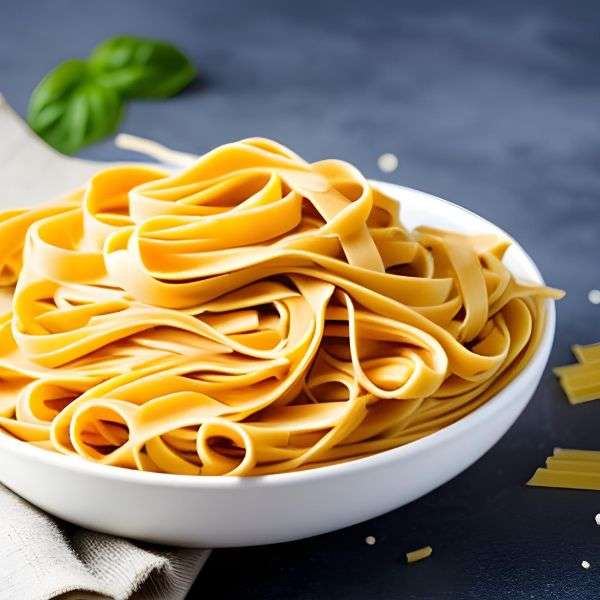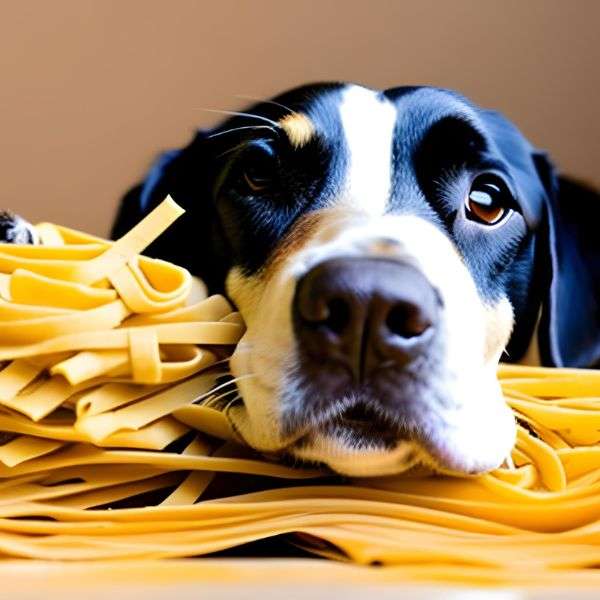Many dog owners wonder “Can dogs eat dried pasta?” The short answer is yes, dried pasta is not a harmful treat for dogs.
Let’s discuss the health benefits and some risks associated with the consumption and some best tips for serving dried pasta to your dogs. So, let’s get into the article and explore the facts!
Understanding Dried Pasta
Dried pasta is a type of pasta that is made by drying cooked pasta to remove moisture, which makes this treat special.
It is commonly found in various shapes, such as spaghetti, penne, fusilli, and macaroni, and is made from durum wheat or flour mixed with water.

The dough is typically formed into the desired shape and then dried through a process of air-drying or dehydration. The result comes out as dried pasta, that can be stored for a long time without a refrigerator.
Dried pasta is an ingredient that can be used as the foundation for many different dishes. It is also prepared by boiling it in water until it becomes soft and then cooked with various sauces, vegetables, meats, or cheeses to create a wide range of dishes.
Can Dogs Eat Dried Pasta?
Yes, dogs can eat dried pasta, but moderation is required. You should not add any seasonings or spices, as they can be toxic to dogs’ health.
Cooked pasta is better because it can be digested easily. You must make sure that the pasta is cooled and it is cut into small sizes so it does not result in choking.
Health Benefits of Dried Pasta for Dogs

Moderate Caloric Content: Dried pasta is considered good food as it provides balanced nutrition and cannot lead to obesity. If you control the amount of the past you feed, it can be a great diet and can not result in health issues.
Energy Source: Dried Pasta contains protein which can be a great source of energy for your dog. This is particularly beneficial for active dogs, supporting their overall well-being.
Low in Fat: Dried pasta is generally low in fat, which makes it a good choice for dogs with dietary restrictions. Low-fat pasta can improve cardiovascular health and can help to maintain optimal body condition.
Easy Digestion: If the pasta is properly cooked, it can lead to better digestive health for your dog. The gentle nature of pasta on the digestive system ensures nutrient absorption without causing digestive discomfort.
Plain and Additive-Free Options: You should choose plain pasta without additives to make sure your dog receives essential nutrients without harmful substances. This minimizes the risk of allergic reactions or adverse effects associated with added ingredients.
Versatility: Pasta can be served in various ways, providing flexibility in preparation to suit different canine preferences. This versatility enhances palatability and encourages dogs to enjoy their meals.
Nutrient-Rich: While not a complete meal, pasta contains some essential nutrients like iron and vitamin B. Whole wheat pasta, in particular, is high in fiber, contributing to digestive health and overall nutritional balance.
Potential Risk Associated with Dried Pasta for Dog Health
Pasta looks tasty and harmless for dogs’ health, but some health risks can occur if eaten in large amounts. So Here are some of them:
Gluten Sensitivity:
As mentioned earlier, dried pasta is usually made from wheat, which contains gluten. Some dogs may have a sensitivity to gluten, which can lead to digestive issues such as gas, bloating, diarrhea, or vomiting.
If you have noticed that your dog has gluten sensitivity, then you must avoid feeding dried pasta to your furry friend.

Seasonings and Sauces:
Many people use different types of sauces, spices, and seasonings in dried pasta that can be toxic and harmful to dogs. Such ingredients can cause digestive upset or damage to your dog’s red blood cells.
So you should serve pasta that is free of any harmful additives and seasonings that provide some healthy nutrition to your dog.

How to Serve Dried Pasta to Your Dogs?
Here are some best steps to follow:
Plain Preparation: You should serve plain, cooked pasta without adding any seasonings, such as salt, sauces, or oil, to ensure the dish is dog-friendly and easily digestible for dogs.
Cooked and Softened: You must cook the pasta completely and soften it to avoid any potential choking hazards. Raw pasta for dogs is not good and cooked pasta reduces the risk of digestive issues and enhances palatability.
Moderation is Key: While plain pasta can be part of a dog’s diet, moderation is important. So you should limit the amount that you offer to reduce the risk of digestive issues, and obesity. Consider pasta as an occasional treat rather than a regular meal.
Can Dogs Eat Dried Pasta Raw?
While dogs can technically eat raw dried pasta, it is not recommended. Raw pasta is hard for them to digest, and it may cause stomach discomfort.
Additionally, the uncooked starches in pasta might lead to bloating or digestive issues in some dogs. It’s safer and healthier to cook the pasta before offering it to your furry friend.
FAQS
Can dogs eat cooked pasta?
Cooked pasta can be safe for dogs to eat but make sure to feed in small amounts and without any seasonings and spices. Plain-cooked pasta, such as plain-boiled noodles or plain-boiled rice-shaped pasta, can be given as an occasional treat.
Can dogs eat raw pasta?
Raw pasta is not recommended for dogs. Raw pasta can be difficult for dogs to digest, and uncooked starches can cause stomach upset or digestive blockages. It’s best to cook pasta thoroughly before offering it to your dog.
Are there any pasta shapes that are safer for dogs?
When offering pasta to your dog, it’s best to stick to simpler shapes like plain noodles or rice-shaped pasta. These types of pasta can be easily chewed and digested by dogs.
Can dogs eat whole wheat or gluten-free pasta?
Whole wheat or gluten-free pasta can be a very good option for dogs. However, it’s important to monitor your dog’s reaction to these alternatives. But ist good to check the reaction as there can be still some ingredients that your dog can find sensitive.
How much pasta can I give my dog?
Pasta should only be given to dogs in small portions as an occasional treat. The quantity should be according to your dog’s size and age and its nutritional needs. It’s good to avoid feeding your dog too much pasta because of the issues it can cause.
What are the signs of pasta intolerance or allergies in dogs?
The signs of pasta allergies in your dog can be seen as symptoms like vomiting, diarrhea, excessive gas, or bloating. If you notice any adverse reactions after feeding your dog pasta, stop feeding it your dog and talk immediately to your vet.
Conclusion
Dried pasta is not toxic for dogs but it can not fulfill the nutritional requirements of dogs. You can only feed it occasionally and make sure it is free of any harmful ingredients or you can look for many other alternatives as well.
Happy Snacking!
